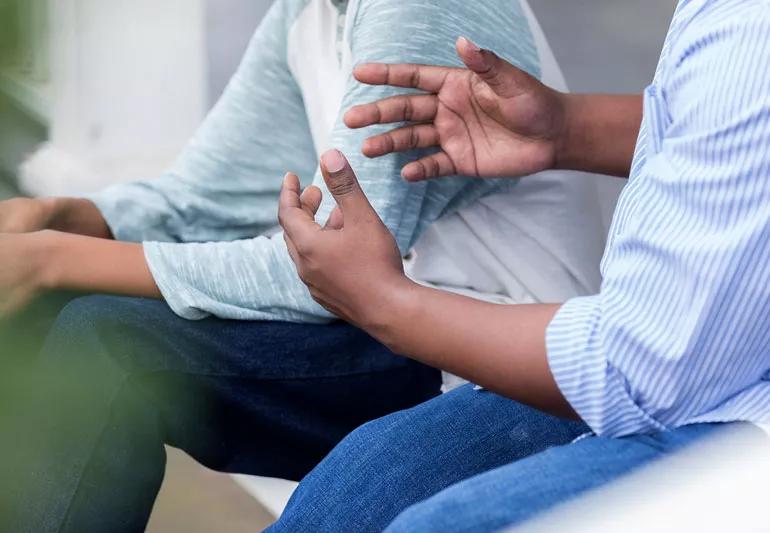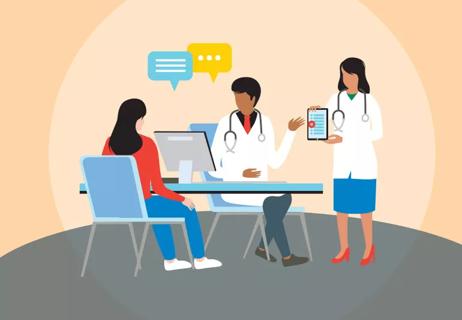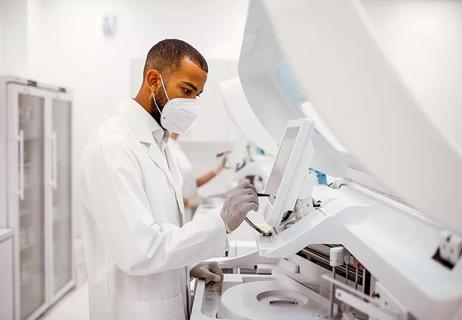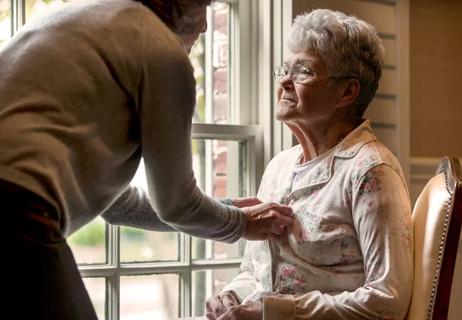Lead with what you’ve learned and create space for expectations

Understanding and processing your cancer diagnosis can be challenging. While coming to terms with having lymphoma, you may have to field questions and concerns from family and friends who want to offer their support — and navigating those conversations can be a challenge all on its own.
Advertisement
Cleveland Clinic is a non-profit academic medical center. Advertising on our site helps support our mission. We do not endorse non-Cleveland Clinic products or services. Policy
Oncologist Robert Dean, MD, provides tips for understanding your diagnosis and helps answer some common questions people may have.
To better explain your diagnosis, you have to understand what lymphoma is, how it spreads and how it’s treated. Lymphoma is a type of blood cancer. When most people hear “blood cancer,” they tend to think of leukemia, a liquid cancer that originates in blood marrow and flows throughout your body in your bloodstream. But lymphomas are solid tumors made of white blood cells (called lymphocytes) that originate in your lymphatic system.
You can think of your lymphatic system as a network of gutters or drainage channels.
“The lymphatic system collects excess fluid (called lymph) that drains out of our tissues and funnels it back into our bloodstream,” explains Dr. Dean.
Along these channels, you have bean-shaped glands called lymph nodes that function like guard stations. In total, your body contains about 600 of these lymph nodes. As part of your immune system, your lymph nodes help store and grow lymphocytes until they’ve fully matured into fully functioning antibody-making immune cells. These cells then work to monitor and destroy foreign invaders like bacteria, viruses, parasites and fungi that enter your body.
Advertisement
When you have an infection, lymphocytes multiply and divide rapidly inside your lymph node so they can fight off the infection. This is why your lymph nodes swell and can become tender when you’re ill.
Rapidly multiplying cells aren’t necessarily a bad thing, but when your lymphocytes lose control of their cell division and change into rapidly growing cancer cells that don’t die, you develop lymphoma.
“With lymphoma, you’re dealing with a form of white blood cell that normally travels to different places in the body as part of its regular everyday work,” Dr. Dean explains. “Because of that, we think about lymphomas similarly to how we think about leukemia as being a system-wide form of cancer from the get-go.”
Because of the widespread network of the lymphatic system, lymphomas can develop in and travel to different parts of your body, including your lymph nodes, bone marrow, spleen and other organs.
There are two main types of lymphomas:
Of those main lymphomas, there are several subtypes with varying symptoms and growth patterns. There are at least 70 subtypes of non-Hodgkin lymphomas and six Hodgkin lymphomas. These subtypes can be aggressive and fast-growing like diffuse large B-cell lymphoma or indolent (slow-growing) like follicular lymphoma, and other, rare types like mantle cell lymphoma, start growing slowly before their eventual fast growth in later stages.
Treatment varies depending on the subtype of lymphoma you have. And because lymphomas come from white blood cells, they can have wide-ranging patterns of growth, so surgery isn’t typically used for treatment.
“If you try surgery, you end up playing a game of ‘Whac-A-Mole,’ where you think you’ve taken out everything that you could see, but then it pops up somewhere else,” notes Dr. Dean.
Instead, doctors will often rely on a combination of chemotherapy and immunotherapy drugs to attack and kill lymphoma cells and reduce tumor growth. Everyone responds to treatment differently, but in many cases, it can involve up to six rounds over four to six months.
As with most forms of chemotherapy, side effects that can occur during treatment include:
Advertisement
There are ways of managing these side effects, so it’s important to maintain communication with your healthcare team as you undergo treatment.
For specific subtypes like diffuse large B-cell lymphoma, other treatments like CAR T-cell therapy, polatuzumab vedotin and tafasitamab may also be beneficial, especially if the cancer isn’t eliminated with the first course of treatment.
“For many types of lymphoma, there isn’t a single, standard treatment approach that is right for everyone,” states Dr. Dean. “Instead, treatments often need to be tailored to the specific situation, including the kind of lymphoma and your health status.”
Your lymphoma diagnosis can be a lot to take in, even when you know you can rely on your oncologist and healthcare team for support. But how do you boil all of that information down into something your family and friends can understand? And when should you tell them?
Talking about your diagnosis may be uncomfortable, but if it’s important for you to share that information with others, you might want to think about how you’d like to deliver that information.
For some people, it’s better to have the conversation in a quiet place, face-to-face, where you and your loved ones can talk about it freely. That way you can answer any questions they may have and they have the space to process that information. Others may want to talk about their diagnosis over the phone.
Advertisement
Take time to prepare yourself for the conversation by learning about your diagnosis and treatment plan — and if you have questions, make sure you direct them to your oncologist who can talk about your specific situation.
The more you know, the more equipped you’ll be to have this conversation with others. And the more detailed information you share, the better people can respond and react in kind. This doesn’t mean you have to tell them every detail about your diagnosis or treatment plan (should you choose to pursue treatment), but being straightforward about the information you give them and setting future expectations can help you and others navigate this process together.
“One of the things that really rocks people mentally as they’re dealing with a diagnosis like this is the uncertainty about what the future is going to hold and what it takes away from them,” says Dr. Dean.
“The first thing I would say is that you shouldn’t make assumptions about how you’re going to feel and what you’re going to be able to do until you’ve gotten through your first treatment. On the flip side, you shouldn’t assume you can’t do anything.”
You can explain your lymphoma to a child by telling them about your diagnosis in a way they can understand. Some helpful tips include:
Advertisement
“It’s natural to want to protect a child from feeling worried or afraid, and sometimes, your first instinct might be to avoid telling a child about your diagnosis. But kids are smart, and they pick up on what is happening around them, even if they don’t ask questions,” says Dr. Dean.
“Sharing some information about your diagnosis with your child can help them understand what to expect, and that can help them feel less scared or confused in the end. Talking with a social worker can give you some ideas on how to start this conversation with your child, too.”
While conversation about your diagnosis may be an ongoing experience as things develop, above all, it’s important to express how you’re feeling during this process. Letting people know what you expect from them and what you expect from your own experience going forward is key to making sure everyone is on the same page about what’s happening under your terms.
It’s also important to acknowledge the mental, emotional and physical toll your cancer may have on you in the coming days, weeks, months or years.
Living with cancer requires patience from everyone in your life. There will be days when you feel tired or overwhelmed. It’s OK to experience these feelings and to ask for help when you need it. And on days when you’re feeling your best, or even just OK, it can help to maintain some sense of normalcy by doing the things you love.
“I encourage people to stay engaged and involved in the things that are helpful for them because it helps keep them mentally resilient as they’re going through treatment,” says Dr. Dean.
This goes without saying, but it’s certainly worth a reminder: Your No. 1 resource is your oncologist. There are several questions you can ask during the course of your treatment if you ever need clarity, explanation or just additional support.
“Your oncologist can really be your copilot as you’re going down this road of treatment and recovery,” stresses Dr. Dean.
Other important resources include:
“The process of cancer treatment is complicated in a lot of ways,” recognizes Dr. Dean. “But there’s a lot that lies behind why we do what we do. If something isn’t making sense, you should feel empowered to ask for more information.”
Learn more about our editorial process.
Advertisement

Working has its benefits, but it may require some modifications — and that’s OK

Working has its benefits, but it may require some modifications — and that’s OK

It’s important to take time for yourself as you go through your cancer journey

A support system you trust and a care team you’re comfortable with can help you adjust

Vaccination is a good idea before or after treatment

Biomarker testing tells doctors how to target their treatments

The first step is making a commitment to communicate

How to prepare when bringing older relatives in-house

Type 2 diabetes isn’t inevitable with these dietary changes

Applying a hot or cold compress can help with pain